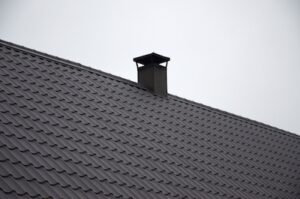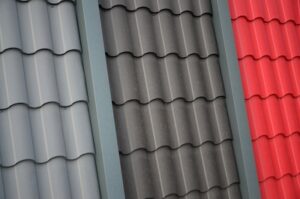Pros and Cons of Metal Roofing
When it comes to choosing the right roofing material for your home, there are various options available in the market. One popular choice that has gained significant attention in recent years is metal roofing. Metal roofs offer a unique set of advantages and disadvantages that homeowners should consider before making a decision. In this article, we will explore the pros and cons of metal roofing for your home, providing you with valuable insights to help you make an informed choice.

House with a Metal Roof
If a person is not a specialist in the construction field, it will be quite difficult for him to decide. One thing can be said: almost any material will be suitable for covering a new building. Restrictions may be financial opportunities. But you will definitely need a metal roof cost estimate because sometimes it is very difficult to make such calculations. As a rule, the price may depend on such factors as the manufacturer, the amount of work, the number of metal tiles, etc.
Let’s start with a few key factors to consider:
- Application Area: If the building is not new and even dilapidated, then the strength of the roof structure and the walls themselves must be taken into account.
- Metal Tile: A Heavy Type of Roofing Material – in this case, is not suitable, as deformation of the building may occur
- Type of Construction: Frame or Capital
- Weight: Light and Heavy Roofing
- Type of Roof: Flat or Pitched
- Financial Opportunities
- Load Resistance: Depends on Climatic Conditions
- Lifetime
- Roof Exterior
History of Metal Roofing
Since about the 10th century, we have been familiar with metal roofing. Then a material made of lead was used, which was used to cover church domes. In the 14th century, domes began to be covered with copper, and sometimes even with gold. Everyone knows that this type of roofing was too expensive. Later, a special sign of wealth was a metal roof made of forged or tinned metal.
In the second half of the 19th century, sheet metal appeared and the price of a metal roof became more affordable. This led to the displacement of tinned and wrought iron. Galvanized iron came into fashion, which conquered the building materials market.
In Soviet times, iron roofing was used less frequently, as sheet slate took its place. And only after a long time, the iron roof again returns to the roofs of private houses and high-rise buildings.
The current galvanized roof is very different from the roof used in the last century. It is much more durable, practical and most importantly – does not corrode. Such roofing can be used for regular and sloping roofs: garages, terraces, canopies, mansards, etc.
If you decide to update your roof and choose a metal roof, you should understand that the term “metal” is very general. The roof is made of zinc, copper, aluminum, stainless steel, etc.
The Pros of Metal Roofing for Your Home
Metal roofing comes with several benefits that make it an attractive option for homeowners. Let’s delve into the advantages of choosing metal roofing for your home:
1. Longevity and Durability
Metal roofs are known for their exceptional durability and longevity. Unlike traditional asphalt shingles that may need to be replaced every 15 to 30 years, metal roofs can last 50 years or more with proper maintenance. They are resistant to cracking, warping, and corrosion, making them a reliable choice for long-term protection.
2. Enhanced Energy Efficiency
Metal roofing is highly reflective, which means it can reflect a significant amount of solar heat, helping to keep your home cooler during the hot summer months. This reflective property reduces the need for excessive air conditioning and can result in energy savings. Additionally, metal roofs can be coated with specialized paints that further enhance their energy efficiency.
3. Fire Resistance
One of the significant advantages of metal roofing is its fire resistance. Unlike combustible roofing materials such as wood, metal roofs are non-combustible, providing an added layer of safety and protection for your home. This feature can be particularly beneficial if you live in an area prone to wildfires or lightning strikes.
4. Low Maintenance
Metal roofs require minimal maintenance compared to other roofing materials. They are resistant to rot, mildew, and insect and pest infestations, eliminating the need for frequent repairs. Regular inspections and occasional cleaning are usually sufficient to keep a metal roof in excellent condition for years to come.
5. Environmentally Friendly
Metal roofing is an environmentally friendly choice for your home. Most metal roofs are made from recycled materials, and they are fully recyclable at the end of their lifespan. Additionally, the longevity of metal roofs reduces the need for frequent replacements, minimizing waste and the environmental impact associated with roofing materials.
6. Wide Selection
Metal roofs come in a wide variety of metals and finishes. Also, they are available in many roof design styles: classic, modern, any individual design, etc.

The Cons of Metal Roofing for Your Home
While metal roofing offers numerous advantages, it’s essential to consider the potential drawbacks before making a final decision. Let’s explore some of the cons associated with metal roofing:
1. Noise Levels
Some homeowners express concerns about the noise generated by rain or hail hitting a metal roof. While metal roofing can be noisier than other materials during heavy rain or hailstorms, modern metal roofs are designed with soundproofing elements such as insulation and solid sheathing to minimize noise. Additionally, the sound of rain on a metal roof can create a cozy and relaxing atmosphere for some individuals.
2. Denting
Metal roofs can be susceptible to denting from severe hailstorms or falling branches. However, it’s important to note that modern metal roofs are typically designed to withstand such impacts. High-quality metal roofing materials are often tested to meet stringent industry standards for impact resistance, reducing the risk of significant damage.
3. Expansion and Contraction
Metal roofs can expand and contract with temperature changes. This natural process can cause the fasteners to loosen over time, potentially leading to leaks. Also, due to certain chemical properties, the iron roof nevertheless oxidizes over time, therefore it must be treated with certain compositions or paint, sometimes completely changed.
However, professional installation and regular preventative maintenance by experienced roofing contractors can help mitigate this issue by allowing for proper ventilation and accommodating the expansion and contraction of the metal panels. As well as prevent the possibility of large losses of material during the installation of complex structures.
4. Style Limitations
While metal roofing comes in a variety of styles and colors, it may not suit every architectural design or personal aesthetic preference. Some homeowners may find that metal roofs are more suitable for modern or contemporary homes, while others may prefer the traditional look of asphalt shingles. It’s important to consider the overall style and appearance of your home before deciding on a metal roof and to choose the color that best matches the main elements of your building.
5. Initial Cost
One of the primary concerns for homeowners considering metal roofing is the initial cost. Metal roofs tend to have a higher upfront cost compared to traditional roofing materials like asphalt shingles. However, it’s important to note that the long-term benefits, such as increased durability and energy efficiency, can often offset the initial investment.
FAQs (Frequently Asked Questions)
Are metal roofs noisy during rain or hailstorms?
While metal roofs can be noisier than other materials during heavy rain or hailstorms, modern metal roofs are designed with soundproofing elements to minimize noise. Additionally, some individuals find the sound of rain on a metal roof soothing.
Can metal roofs be damaged by hail or falling branches?
Metal roofs can be susceptible to denting from severe hail or falling branches. However, high-quality metal roofing materials are often designed to withstand such impacts and meet industry standards for impact resistance.
Do metal roofs require a lot of maintenance?
No, metal roofs require minimal maintenance compared to other materials. They are resistant to rot, mildew, and insect infestations, reducing the need for frequent repairs. Regular inspections and occasional cleaning are typically sufficient to keep a metal roof in excellent condition.
Can metal roofs be installed on any type of home?
While metal roofs come in various styles and colors, they may not suit every architectural design or personal aesthetic preference. Some homeowners may find metal roofs more suitable for modern or contemporary homes, while others may prefer the traditional look of asphalt shingles.
Conclusion
Choosing the right roofing material for your home is a crucial decision that requires careful consideration. Metal roofing offers a range of benefits, including longevity, energy efficiency, fire resistance, low maintenance, and environmental friendliness. However, it’s important to weigh these advantages against the potential drawbacks, such as the initial cost, noise levels, and style limitations. By understanding the pros and cons of metal roofing, you can make an informed choice that best suits your home’s needs and your personal preferences.
